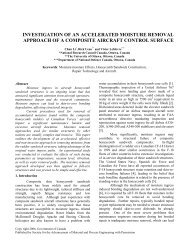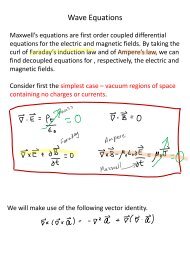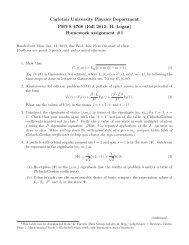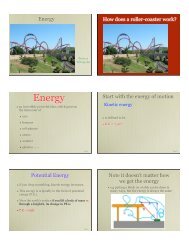Assignment 3 [pdf] - Department of Physics - Carleton University
Assignment 3 [pdf] - Department of Physics - Carleton University
Assignment 3 [pdf] - Department of Physics - Carleton University
Create successful ePaper yourself
Turn your PDF publications into a flip-book with our unique Google optimized e-Paper software.
<strong>Carleton</strong> <strong>University</strong> <strong>Physics</strong> <strong>Department</strong><br />
PHYS 4708 (Fall 2012, H. Logan)<br />
Homework assignment #3<br />
Handed out Mon. Feb. 4, 2013; due Wed. Feb. 13 at the start <strong>of</strong> class.<br />
Problems are worth 5 points each unless noted otherwise.<br />
1. Compute the energy shift from the anomalous Zeeman perturbation,<br />
∆EB = eB<br />
2me<br />
〈φℓjmj |Jz + Sz|φℓjmj 〉, (1)<br />
for the n = 2 states <strong>of</strong> the hydrogen atom using the “brute force” method <strong>of</strong> expressing the<br />
eigenstates |φℓjmj 〉 as a linear combination <strong>of</strong> |mℓms〉 states in order to evaluate the matrix<br />
elements <strong>of</strong> Sz. (Use the table <strong>of</strong> Clebsch-Gordan coefficients to get the appropriate linear<br />
combinations.) Compare your results to the shifts found using Eq. (12-24) <strong>of</strong> the textbook,<br />
∆EB = eB¯h<br />
2me<br />
mj<br />
<br />
1 +<br />
<br />
j(j + 1) − ℓ(ℓ + 1) + 3/4<br />
. (2)<br />
2j(j + 1)<br />
2. Work out the energies for the Lyman-α transition spectral lines in hydrogen (relative to the<br />
zeroth-order energy ∆E2→1 = (3/4)EBohr 1 ) for the three following situations in the presence<br />
<strong>of</strong> an external magnetic field B = Bˆz:<br />
(a) A fake situation in which the electron has no spin.<br />
(b) The case that the splitting due to the external B-field is very large compared to the fine<br />
structure, so that the fine structure can be ignored (work in the eigenbasis <strong>of</strong> definite mℓ<br />
and ms).<br />
(c) The anomalous Zeeman case in which fine structure is a larger effect than the Zeeman<br />
splitting (feel free to use the final results for the energy shifts from the text or lecture).<br />
Note: Remember that this electric dipole transition obeys the selection rules ∆ℓ = ±1, ∆mℓ =<br />
0, ±1 and that an electric dipole transition cannot flip the spin <strong>of</strong> the electron.<br />
3. (Gasiorowicz 3rd edition problem 12-5) Consider a harmonic oscillator in three dimensions. If<br />
the relativistic expression for the kinetic energy is used, what is the shift in the ground-state<br />
energy?<br />
Hint: treat the relativistic correction as a small perturbation as we did for the hydrogen atom.<br />
Because the harmonic oscillator Hamiltonian can be written as H0 = |p| 2 /2m + mω 2 r 2 /2 =<br />
|p| 2 /2m + V (x) + V (y) + V (z), where V (x) = mω 2 x 2 /2, etc., the three-dimensional harmonic<br />
oscillator can be solved by separation <strong>of</strong> variables in Cartesian coordinates with the result<br />
ψE(x, y, z) = un1(x)un2(y)un3(z), (3)<br />
where the functions u are the 1-dimensional harmonic oscillator solutions in each direction.<br />
The corresponding energy eigenvalues are E = ¯hω(n1 + n2 + n3 + 3/2).
4. (similar to Gasiorowicz 3rd edition problem 13-3) Consider two noninteracting electrons in a<br />
one-dimensional infinite potential well.<br />
(a) What is the ground-state wave function <strong>of</strong> the two-electron system if the two electrons<br />
are in the same spin state?<br />
(b) Re-express the ground-state wave function in terms <strong>of</strong> the relative coordinate x ≡ x1 −x2<br />
and the centre-<strong>of</strong>-mass coordinate X ≡ (x1+x2)/2. Square to obtain the joint probability<br />
density P (x, X) and integrate over X to find the probability density for the relative<br />
coordinate P (x). Make a sketch <strong>of</strong> P (x). What is the average separation between the<br />
two electrons?<br />
5. Consider N spinless particles in a 3-dimensional infinite square well with sides <strong>of</strong> length L.<br />
(a) Compute the total energy <strong>of</strong> the ground state <strong>of</strong> this system <strong>of</strong> N particles, assuming<br />
that the particles are distinguishable. What is the total energy <strong>of</strong> the ground state if the<br />
particles are identical bosons?<br />
(b) Compute the total energy <strong>of</strong> the first excited state <strong>of</strong> the system. What is the degeneracy<br />
<strong>of</strong> this state for the system <strong>of</strong> N distinguishable particles? What is the degeneracy if the<br />
N particles are identical bosons?<br />
(c) At finite temperature T , the probability <strong>of</strong> a system being in a particular quantum<br />
state with total energy E is e −E/kBT (divided by a normalization factor), where kB is<br />
Boltzmann’s constant. Compute the relative probability P (1st excited)/P (ground state)<br />
for the system <strong>of</strong> N distinguishable particles and for the system <strong>of</strong> N identical bosons.<br />
(Note: this statistical effect is why noninteracting bosons seem to like all being in the<br />
same state.)


![Assignment 3 [pdf] - Department of Physics - Carleton University](https://img.yumpu.com/19038221/1/500x640/assignment-3-pdf-department-of-physics-carleton-university.jpg)




![Assignment 2 [pdf] - Department of Physics - Carleton University](https://img.yumpu.com/19038215/1/190x245/assignment-2-pdf-department-of-physics-carleton-university.jpg?quality=85)




![Assignment 7 [pdf] - Department of Physics - Carleton University](https://img.yumpu.com/19038096/1/190x245/assignment-7-pdf-department-of-physics-carleton-university.jpg?quality=85)

